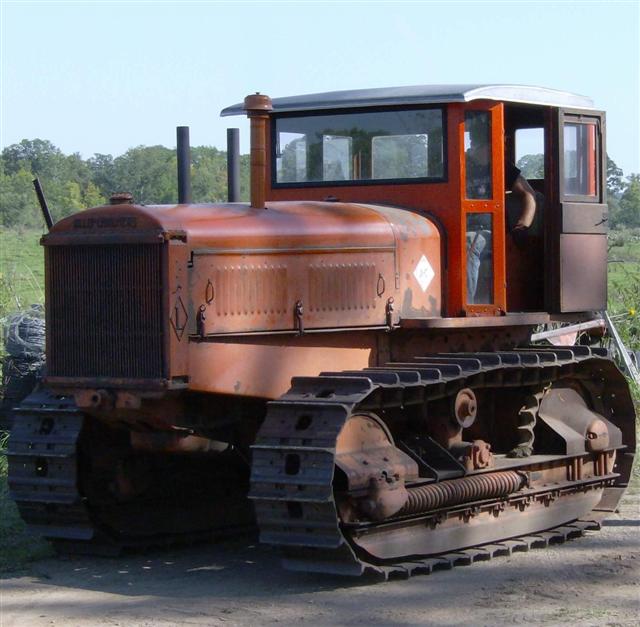| Author |
 Topic Search Topic Search  Topic Options Topic Options
|
Dennis(IA) 
Silver Level


Joined: 12 Sep 2009
Location: IOWA
Points: 356
|
 Post Options Post Options
 Thanks(0) Thanks(0)
 Quote Quote  Reply Reply
 Topic: Switching to 12 volt Topic: Switching to 12 volt
Posted: 09 May 2019 at 4:10pm |
|
Switching my 45 to 12 volt. My question is, the hot wire running to the alternater (used to be on the cutout) is hot all the time, do I need to hook it up to the ignition switch so it shuts off?
Dennis
|
 |
|
Sponsored Links
|
|
 |
CTuckerNWIL 
Orange Level


Joined: 11 Sep 2009
Location: NW Illinois
Points: 22824
|
 Post Options Post Options
 Thanks(0) Thanks(0)
 Quote Quote  Reply Reply
 Posted: 09 May 2019 at 5:14pm Posted: 09 May 2019 at 5:14pm |
|
You need a diode in between the alternator and the ignition switch, or you won't be able to shut the tractor off.
|
|
|
 |
Dennis(IA) 
Silver Level


Joined: 12 Sep 2009
Location: IOWA
Points: 356
|
 Post Options Post Options
 Thanks(0) Thanks(0)
 Quote Quote  Reply Reply
 Posted: 09 May 2019 at 5:33pm Posted: 09 May 2019 at 5:33pm |
|
Thanks CT. But do I have to stop the 12 V going to the alternator when the tractor is not running?
So if I put a diode at the alternator I would not wire it to the switch.
|
 |
JC-WI 
Orange Level Access


Joined: 11 Sep 2009
Location: wisconsin
Points: 34278
|
 Post Options Post Options
 Thanks(0) Thanks(0)
 Quote Quote  Reply Reply
 Posted: 09 May 2019 at 6:18pm Posted: 09 May 2019 at 6:18pm |
If you are running a one wire alternator, No. don't even need a diode in line... If you are running a two wire alternator, then you still don't need anything from the charging post on the alternator, to the ammeter, but you do have to put a diode in the exciter wire or it will back feed to the distributor. Question is, what alternator are you putting on?
Now, If you have the old push/pull position light switch, you can wire that to run front lights and all the way out be front and rear lights. or front lights and rear light and all the way out it would turn on extra lights. Thats what I did... I set my switch so it would be off all the way in, first position be front and rear lights with a switch on the rear work light and all the way out, it fired up the Firecracker halogens lights on the hood too. Boy did that tractor have lights. Sadly at the moment, I don't remember how I changed it to do that but it would not take long to open the box and take a pic.
|
|
He who says there is no evil has already deceived himself
The truth is the truth, sugar coated or not. Trawler II says, "Remember that."
|
 |
Jim.ME 
Orange Level

Joined: 19 Nov 2016
Location: Maine
Points: 962
|
 Post Options Post Options
 Thanks(0) Thanks(0)
 Quote Quote  Reply Reply
 Posted: 09 May 2019 at 6:25pm Posted: 09 May 2019 at 6:25pm |
|
You do not have to stop power going to the output terminal of the alternator. Depending on the alternator you use (one wire or three wire), you may need a diode or idiot light to prevent feedback from the excitation terminal.
Go to Steve's site (B&B Custom Circuits), he has info on the differences in the types there.
|
 |
Dennis(IA) 
Silver Level


Joined: 12 Sep 2009
Location: IOWA
Points: 356
|
 Post Options Post Options
 Thanks(0) Thanks(0)
 Quote Quote  Reply Reply
 Posted: 09 May 2019 at 6:39pm Posted: 09 May 2019 at 6:39pm |
|
It is a one wire alternator.
|
 |
DougS 
Orange Level


Joined: 03 Nov 2011
Location: Iowa
Points: 2490
|
 Post Options Post Options
 Thanks(0) Thanks(0)
 Quote Quote  Reply Reply
 Posted: 10 May 2019 at 5:03am Posted: 10 May 2019 at 5:03am |
|
With a one wire you simply hook the alternator to the ammeter where the generator wire used to go. Tie off the F wire that used to run to the generator. Yes, the battery will always be putting voltage to the alternator, but the alternator's diodes should be blocking any current when the alternator isn't turning.
|
 |
jaybmiller 
Orange Level Access

Joined: 12 Sep 2009
Location: Greensville,Ont
Points: 24571
|
 Post Options Post Options
 Thanks(0) Thanks(0)
 Quote Quote  Reply Reply
 Posted: 10 May 2019 at 5:33am Posted: 10 May 2019 at 5:33am |
re: Yes, the battery will always be putting voltage to the alternator, but
the alternator's diodes should be blocking any current when the
alternator isn't turning.
yeah..until enough mud and gorf and dampness gets in there, then that crud slowly drains the battery....BTDT, found out it's a GOOD idea to clean your JEEP after going 'offroad'...
|
|
3 D-14s,A-C forklift, B-112
Kubota BX23S lil' TOOT( The Other Orange Tractor)
Never burn your bridges, unless you can walk on water
|
 |
Steve in NJ 
Orange Level Access


Joined: 12 Sep 2009
Location: Andover, NJ
Points: 11978
|
 Post Options Post Options
 Thanks(0) Thanks(0)
 Quote Quote  Reply Reply
 Posted: 10 May 2019 at 6:57am Posted: 10 May 2019 at 6:57am |
Use a three wire set up. Its much better. As Jim in ME mentioned, visit my website. There's lot's of information on 12V conversions there to guide you to doing it right and most of all SAFE. If you have any questions, just give me a call. I'll be glad to help you out with anything. I also offer complete 12V conversion kits if interested... Website- bb-customcircuits.com
|
|
39'RC, 43'WC, 48'B, 49'G, 50'WF, 65 Big 10, 67'B-110, 75'716H, 2-620's, & a Motorhead wife
|
 |
Sugarmaker 
Orange Level


Joined: 12 Jul 2013
Location: Albion PA
Points: 8448
|
 Post Options Post Options
 Thanks(0) Thanks(0)
 Quote Quote  Reply Reply
 Posted: 10 May 2019 at 7:03am Posted: 10 May 2019 at 7:03am |
I have done several of these and have been happy with the conversions to 12 volt. Its a custom electrical system. I do have a electrical diagram somewhere that I use on these WD series tractors. I believe Steve in NJ helped me set it up. Regards, Chris
|
|
D17 1958 (NFE), WD45 1954 (NFE), WD 1952 (NFE), WD 1950 (WFE), Allis F-40 forklift, Allis CA, Allis D14, Ford Jubilee, Many IH Cub Cadets, 32 Ford Dump, 65 Comet.
|
 |
WF owner 
Orange Level

Joined: 12 May 2013
Location: Bombay NY
Points: 4979
|
 Post Options Post Options
 Thanks(0) Thanks(0)
 Quote Quote  Reply Reply
 Posted: 10 May 2019 at 7:08am Posted: 10 May 2019 at 7:08am |
As in Steve's website, be careful about running a 12 volt conversion through the stock ammeter. You have a lot more charging potential with a 12 volt alternator verses a 6 volt generator and could easily overload the ammeter. I changed to a voltmeter and I'm happy with that.
Edited by WF owner - 10 May 2019 at 7:08am
|
 |
DougS 
Orange Level


Joined: 03 Nov 2011
Location: Iowa
Points: 2490
|
 Post Options Post Options
 Thanks(0) Thanks(0)
 Quote Quote  Reply Reply
 Posted: 10 May 2019 at 7:44am Posted: 10 May 2019 at 7:44am |
|
^^ Yes. A 60-0-60 ammeter is preferred, but with such a wide range it's hard to tell just how much the battery is charging or discharging, especially when the value is only a few amps. My preference would be a voltmeter, but know that you want to be looking at about 14 volts or slightly more, not a mere 12.5 volts when the engine is running. Also, integrate the voltmeter with your key switch. You only want the meter in the circuit when the ignition is switched on.
Edited by DougS - 10 May 2019 at 7:46am
|
 |
Gerald J. 
Orange Level

Joined: 12 Sep 2009
Location: Hamilton Co, IA
Points: 5636
|
 Post Options Post Options
 Thanks(0) Thanks(0)
 Quote Quote  Reply Reply
 Posted: 10 May 2019 at 9:51am Posted: 10 May 2019 at 9:51am |
|
The fundamental limitation with the one wire alternator is that without the charging start excitation wire it has to be spun fast to get it starting charging. Often takes over 2000 RPM at the alternator to get it to start. Once it starts charging it will charge as needed until the engine is stopped. I have a one wire alternator on my gas 4020 and the smallest pulley I could buy for the alternator at a vehicle electric shop, about 2-1/2" diameter with a 7" pulley on the engine crankshaft, takes about 1600 engine RPM to get the alternator charging. After that it charges at engine idle and all other engine speeds.
I have experimented with voltmeter and ammeter and while an voltmeter is easiest to connect it doesn't give proof of the battery being charged, just that there is enough voltage to charge the battery IF the battery is actually connected. The ammeter shows actual battery current and so shows true battery charging and loading.
Gerald J.
|
 |
jaybmiller 
Orange Level Access

Joined: 12 Sep 2009
Location: Greensville,Ont
Points: 24571
|
 Post Options Post Options
 Thanks(0) Thanks(0)
 Quote Quote  Reply Reply
 Posted: 10 May 2019 at 11:48am Posted: 10 May 2019 at 11:48am |
The inherent problem with a one-wire alternator is that it senses the voltage within itself NOT at the battery. There is a definite volatge drop between the alternator and the battery due to the 'IsquaredR ' losses from the battery cables( BOTH of them...). While this is small when using big, fat NEW cables using old ones,even slightly corroded can not allow the battery to receive a proper charge. Perhaps most don't see it, but it is a factor that should be dealt with.
|
|
3 D-14s,A-C forklift, B-112
Kubota BX23S lil' TOOT( The Other Orange Tractor)
Never burn your bridges, unless you can walk on water
|
 |
Gary Burnett 
Orange Level Access


Joined: 11 Sep 2009
Location: Virginia
Points: 3059
|
 Post Options Post Options
 Thanks(0) Thanks(0)
 Quote Quote  Reply Reply
 Posted: 10 May 2019 at 2:42pm Posted: 10 May 2019 at 2:42pm |
Well I run about 10 one wire alternators on various tractors and most of the negative stuff I read here and other places about them is totally false as far as I can see.Start the tractor normally and the alternator starts charging no problem.Let one sit for 2 months it starts right up no problem.The ones I get from DB Electric are 62 Amp far more power than the generator they replaced.They cost about $55 off ebay,you can spend more money but you will not get anything that will keep the battery charged up better.
|
 |









 Topic Options
Topic Options

 Post Options
Post Options Thanks(0)
Thanks(0)






